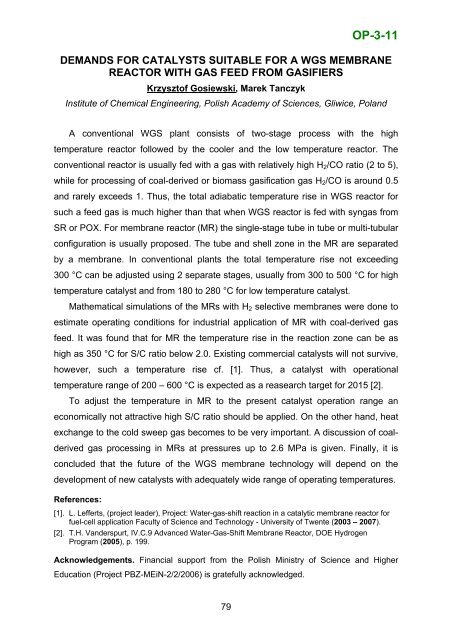Boreskov Institute of Catalysis SB RAS, Novosibirsk, Russia
Boreskov Institute of Catalysis SB RAS, Novosibirsk, Russia
Boreskov Institute of Catalysis SB RAS, Novosibirsk, Russia
- No tags were found...
Create successful ePaper yourself
Turn your PDF publications into a flip-book with our unique Google optimized e-Paper software.
OP-3-11DEMANDS FOR CATALYSTS SUITABLE FOR A WGS MEMBRANEREACTOR WITH GAS FEED FROM GASIFIERSKrzyszt<strong>of</strong> Gosiewski, Marek Tanczyk<strong>Institute</strong> <strong>of</strong> Chemical Engineering, Polish Academy <strong>of</strong> Sciences, Gliwice, PolandA conventional WGS plant consists <strong>of</strong> two-stage process with the hightemperature reactor followed by the cooler and the low temperature reactor. Theconventional reactor is usually fed with a gas with relatively high H 2 /CO ratio (2 to 5),while for processing <strong>of</strong> coal-derived or biomass gasification gas H 2 /CO is around 0.5and rarely exceeds 1. Thus, the total adiabatic temperature rise in WGS reactor forsuch a feed gas is much higher than that when WGS reactor is fed with syngas fromSR or POX. For membrane reactor (MR) the single-stage tube in tube or multi-tubularconfiguration is usually proposed. The tube and shell zone in the MR are separatedby a membrane. In conventional plants the total temperature rise not exceeding300 °C can be adjusted using 2 separate stages, usually from 300 to 500 °C for hightemperature catalyst and from 180 to 280 °C for low temperature catalyst.Mathematical simulations <strong>of</strong> the MRs with H 2 selective membranes were done toestimate operating conditions for industrial application <strong>of</strong> MR with coal-derived gasfeed. It was found that for MR the temperature rise in the reaction zone can be ashigh as 350 °C for S/C ratio below 2.0. Existing commercial catalysts will not survive,however, such a temperature rise cf. [1]. Thus, a catalyst with operationaltemperature range <strong>of</strong> 200 – 600 °C is expected as a reasearch target for 2015 [2].To adjust the temperature in MR to the present catalyst operation range aneconomically not attractive high S/C ratio should be applied. On the other hand, heatexchange to the cold sweep gas becomes to be very important. A discussion <strong>of</strong> coalderivedgas processing in MRs at pressures up to 2.6 MPa is given. Finally, it isconcluded that the future <strong>of</strong> the WGS membrane technology will depend on thedevelopment <strong>of</strong> new catalysts with adequately wide range <strong>of</strong> operating temperatures.References:[1]. L. Lefferts, (project leader), Project: Water-gas-shift reaction in a catalytic membrane reactor forfuel-cell application Faculty <strong>of</strong> Science and Technology - University <strong>of</strong> Twente (2003 – 2007).[2]. T.H. Vanderspurt, IV.C.9 Advanced Water-Gas-Shift Membrane Reactor, DOE HydrogenProgram (2005), p. 199.Acknowledgements. Financial support from the Polish Ministry <strong>of</strong> Science and HigherEducation (Project PBZ-MEiN-2/2/2006) is gratefully acknowledged.79
















